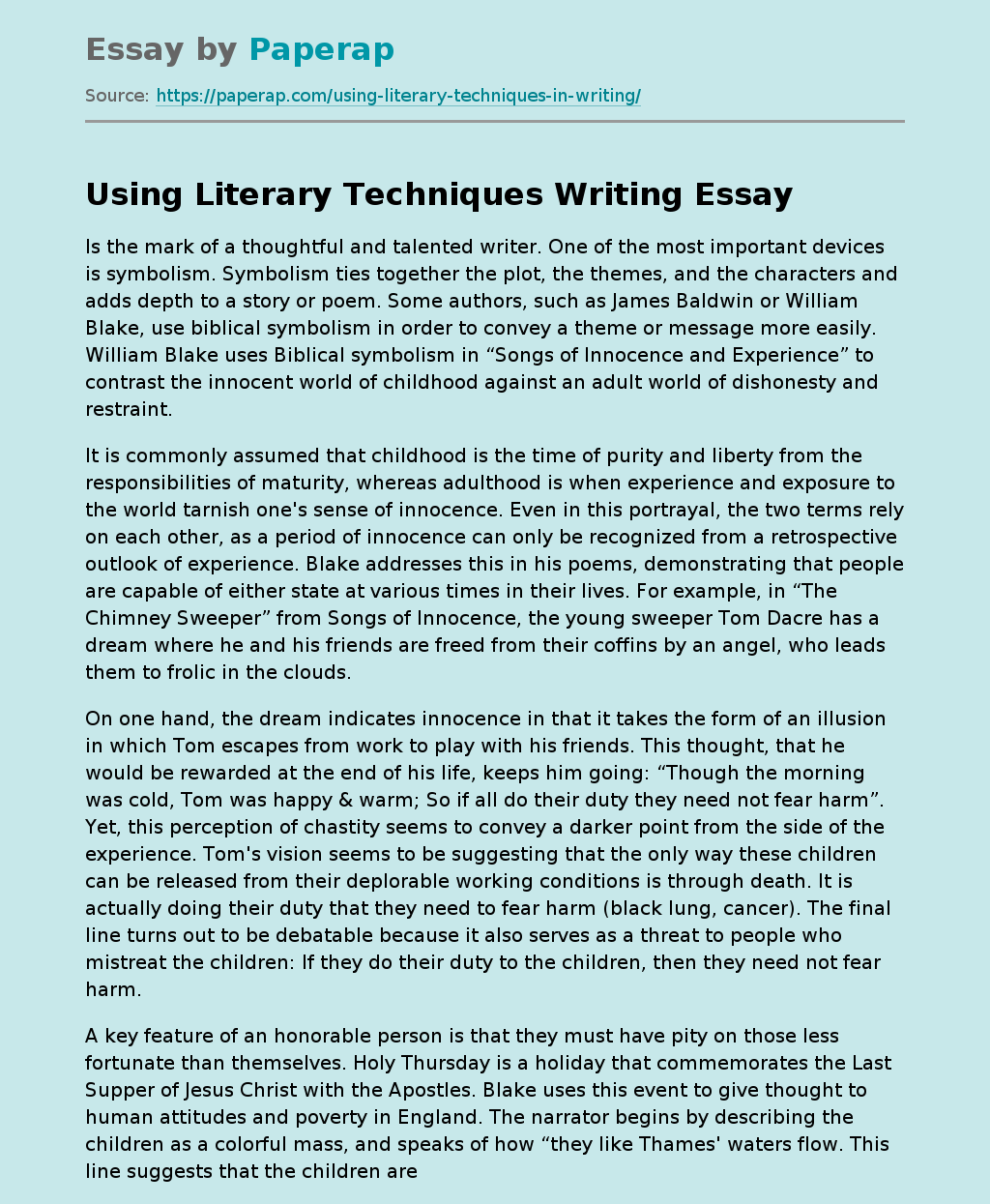Is the mark of a thoughtful and talented writer. One of the most important devices is symbolism. Symbolism ties together the plot, the themes, and the characters and adds depth to a story or poem. Some authors, such as James Baldwin or William Blake, use biblical symbolism in order to convey a theme or message more easily. William Blake uses Biblical symbolism in “Songs of Innocence and Experience” to contrast the innocent world of childhood against an adult world of dishonesty and restraint.
It is commonly assumed that childhood is the time of purity and liberty from the responsibilities of maturity, whereas adulthood is when experience and exposure to the world tarnish one’s sense of innocence. Even in this portrayal, the two terms rely on each other, as a period of innocence can only be recognized from a retrospective outlook of experience. Blake addresses this in his poems, demonstrating that people are capable of either state at various times in their lives.
For example, in “The Chimney Sweeper” from Songs of Innocence, the young sweeper Tom Dacre has a dream where he and his friends are freed from their coffins by an angel, who leads them to frolic in the clouds.
On one hand, the dream indicates innocence in that it takes the form of an illusion in which Tom escapes from work to play with his friends. This thought, that he would be rewarded at the end of his life, keeps him going: “Though the morning was cold, Tom was happy & warm; So if all do their duty they need not fear harm”.
Yet, this perception of chastity seems to convey a darker point from the side of the experience. Tom’s vision seems to be suggesting that the only way these children can be released from their deplorable working conditions is through death. It is actually doing their duty that they need to fear harm (black lung, cancer). The final line turns out to be debatable because it also serves as a threat to people who mistreat the children: If they do their duty to the children, then they need not fear harm.
A key feature of an honorable person is that they must have pity on those less fortunate than themselves. Holy Thursday is a holiday that commemorates the Last Supper of Jesus Christ with the Apostles. Blake uses this event to give thought to human attitudes and poverty in England. The narrator begins by describing the children as a colorful mass, and speaks of how “they like Thames’ waters flow. This line suggests that the children are being carried out by a current of innocence. In the second stanza, the children are presented as “flowers of London town” and as lambs, emphasizing their beauty and their fragility and accentuating their innocence and their relationship with God and religion. This description contrasts with the “hum of multitudes” and furthers the emphasis on the children “raising their innocent hands”. Furthermore, the number of these children and how they are all described as uncorrupted and delicate.
In the final stanza, the children begin singing. They “like a mighty wind they raise to heaven the voice of song”, are no longer fragile, and they acquire a force that enables them to communicate with God. The final line tells the reader to give charity and kindness to the poor, “lest you drive an angel from your door”, which sums up the message of the poem. The collection explores the merits and limitations of two different perspectives on the world. The poems are paired together and are written about the same subject, but one is written from the position of an experienced adult, while the other is seen through the eyes of a simplistic child. Although Blake uses fervent language and expresses strong ideals in each separate poem, he stands outside both of these perspectives in order to understand the values and downfalls of both views. In particular, he criticizes tyrannical authority and restrictive religion; his main concern is the way these entities of power collaborate and subdue the most sacred aspects of human beings.
Many of the poems draw attention to the positive aspects of natural human understanding before the corruption of experience. However, while Blake certainly explicates the emotional power of fundamental Christian values, he also uncovers Christianity’s capacity for promoting injustice and brutality. The Songs of Experience work to lament the ways in which the despotic experiences of adult life demolish what is good in innocence, while also expressing the weaknesses of the innocent perspective “The Tyger,” for example, attempts to account for negative forces in the universe, which the innocent lamb fails to confront).
With regard to religion, the poems are less concerned with the character of individual faith than with the Church and its effects on society and the individual mind. Different literary devices can be used to create various effects. William Blake incorporates symbolism and uses this symbolism to juxtapose two ideas and address social and religious issues that exist around him. He creates a balance between the youthful and the repressed worlds of people in order to vocalize and, in some cases, criticize the church and the government on how they are governing, while also considering human thought and behavior.
Using Literary Techniques Writing. (2021, Dec 14). Retrieved from https://paperap.com/using-literary-techniques-in-writing/

